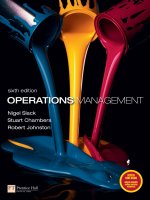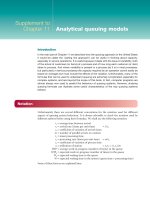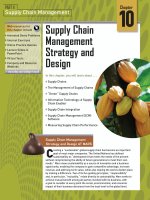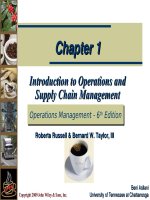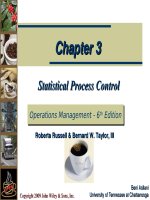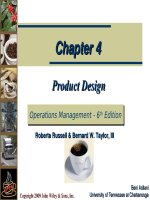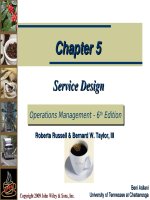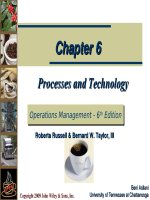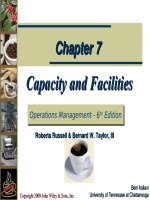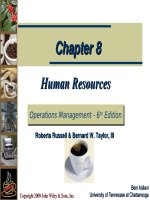Operation management 6e by russel and taylor ch06
Bạn đang xem bản rút gọn của tài liệu. Xem và tải ngay bản đầy đủ của tài liệu tại đây (907.26 KB, 46 trang )
Chapter 6
Processes and Technology
Operations
Operations Management
Management -- 66thth Edition
Edition
Roberta Russell & Bernard W. Taylor, III
Copyright 2009 John Wiley & Sons, Inc.
Beni Asllani
University of Tennessee at Chattanooga
Lecture Outline
Process Planning
Process Analysis
Process Innovation
Technology Decisions
Copyright 2009 John Wiley & Sons, Inc.
6-2
Process Planning
Process
a group of related tasks with specific inputs and
outputs
Process design
what tasks need to be done and how they are
coordinated among functions, people, and
organizations
Process strategy
an organization’s overall approach for physically
producing goods and services
Process planning
converts designs into workable instructions for
manufacture or delivery
Copyright 2009 John Wiley & Sons, Inc.
6-3
Process Strategy
Vertical integration
extent to which firm will produce inputs and control outputs of
each stage of production process
Capital intensity
mix of capital (i.e., equipment, automation) and labor
resources used in production process
Process flexibility
ease with which resources can be adjusted in response to
changes in demand, technology, products or services, and
resource availability
Customer involvement
role of customer in production process
Copyright 2009 John Wiley & Sons, Inc.
6-4
Outsourcing
Cost
Capacity
Quality
Speed
Reliability
Expertise
Copyright 2009 John Wiley & Sons, Inc.
6-5
Process Selection
Projects
one-of-a-kind production of a product to customer order
Batch production
processes many different jobs at the same time in groups or
batches
Mass production
produces large volumes of a standard product for a mass
market
Continuous production
used for very-high volume commodity products
Copyright 2009 John Wiley & Sons, Inc.
6-6
Sourcing Continuum
Copyright 2009 John Wiley & Sons, Inc.
6-7
Product-Process Matrix
Source: Adapted from Robert Hayes and Steven Wheelwright, Restoring the Competitive Edge Competing
through Manufacturing (New York, John Wiley & Sons, 1984), p. 209.
Copyright 2009 John Wiley & Sons, Inc.
6-8
Types of Processes
Type of
product
Type of
customer
Product
demand
PROJECT
BATCH
MASS
CONT.
Unique
Made-toorder
Made-tostock
Commodity
(customized)
(standardized )
Few
individual
customers
Mass
market
Mass
market
Fluctuates
Stable
Very stable
One-at-atime
Infrequent
Source: Adapted from R. Chase, N. Aquilano, and R. Jacobs, Operations Management for Competitive Advantage (New York:McGrawHill, 2001), p. 210
Copyright 2009 John Wiley & Sons, Inc.
6-9
Types of Processes (cont.)
PROJECT
BATCH
MASS
CONT.
Demand
volume
Very low
Low to
medium
High
Very high
No. of
different
products
Infinite
variety
Many,
varied
Few
Very few
Production
system
Long-term
project
Discrete, job
shops
Repetitive,
assembly
lines
Continuous,
process
industries
Source: Adapted from R. Chase, N. Aquilano, and R. Jacobs, Operations Management for Competitive Advantage (New York:McGrawHill, 2001), p. 210
Copyright 2009 John Wiley & Sons, Inc.
6-10
Types of Processes (cont.)
PROJECT
BATCH
MASS
CONT.
Equipment
Varied
Generalpurpose
Specialpurpose
Highly
automated
Primary
type of
work
Specialized
contracts
Fabrication
Assembly
Mixing,
treating,
refining
Worker
skills
Experts,
craftspersons
Wide range
of skills
Limited
range of
skills
Equipment
monitors
Source: Adapted from R. Chase, N. Aquilano, and R. Jacobs, Operations Management for Competitive Advantage (New York:McGrawHill, 2001), p. 210
Copyright 2009 John Wiley & Sons, Inc.
6-11
Types of Processes (cont.)
PROJECT
Advantages
Disadvantages
Examples
BATCH
MASS
CONT.
Custom work,
latest technology
Flexibility,
quality
Efficiency,
speed,
low cost
Highly efficient,
large capacity,
ease of control
Non-repetitive,
small customer
base, expensive
Costly, slow,
difficult to
manage
Capital
investment;
lack of
responsiveness
Difficult to change,
far-reaching errors,
limited variety
Construction,
shipbuilding,
spacecraft
Machine shops,
print shops,
bakeries,
education
Automobiles,
televisions,
computers,
fast food
Paint, chemicals,
foodstuffs
Source: Adapted from R. Chase, N. Aquilano, and R. Jacobs, Operations Management for Competitive Advantage (New York:McGraw-Hill, 2001), p. 210
Copyright 2009 John Wiley & Sons, Inc.
6-12
Process Selection with
Break-Even Analysis
examines cost trade-offs associated with demand volume
Cost
Fixed costs
constant regardless of the number of units produced
Variable costs
vary with the volume of units produced
Revenue
price at which an item is sold
Total revenue
is price times volume sold
Profit
difference between total revenue and total cost
Copyright 2009 John Wiley & Sons, Inc.
6-13
Process Selection with
Break-Even Analysis (cont.)
Total cost
= fixed cost + total variable cost
TC = cf + vcv
Total revenue = volume x price
TR = vp
Profit
= total revenue - total cost
Z = TR – TC = vp - (cf + vcv)
Copyright 2009 John Wiley & Sons, Inc.
6-14
Process Selection with
Break-Even Analysis (cont.)
TR
=
TC
vp = cf + vcv
vp - vcv = cf
v(p - cfv) = cf
p - cv
v = Point (Volume)
Solving for Break-Even
Copyright 2009 John Wiley & Sons, Inc.
6-15
Break-Even Analysis: Example
Fixed cost
= cf =
$2,000
Variable cost = cv =
$5 per raft
Pricepoint
= pis= $10
Break-even
per raft c
f
2000
v=
=
= 400 rafts
p - cv
10 - 5
Copyright 2009 John Wiley & Sons, Inc.
6-16
Break-Even Analysis: Graph
Dollars
Total
cost
line
$3,000 —
$2,000 —
$1,000 —
Total
revenue
line
400
Break-even point
Copyright 2009 John Wiley & Sons, Inc.
Units
6-17
Process Plans
Set of documents that detail manufacturing
and service delivery specifications
assembly charts
operations sheets
quality-control check-sheets
Copyright 2009 John Wiley & Sons, Inc.
6-18
Process Selection
Process A
Process
B + $5v = $10,000 + $3v
$2,000
$2v
= $8,000
v = 4,000 rafts
Below or equal to 4,000, choose A
Above or equal to 4,000, choose B
Copyright 2009 John Wiley & Sons, Inc.
6-19
Process Analysis
• systematic
examination
of all
aspects of
process to
improve
operation
Copyright 2009 John Wiley & Sons, Inc.
6-20
An Operations Sheet for a Plastic Part
Part name
Crevice Tool
Part No.
52074
Usage
Hand-Vac
Assembly No. 520
Oper. No.
Description
Dept.
0
Pour in plastic bits
041 Injection molding
2 min
0
Insert mold
041 #076
2 min
0
Check settings
& start machine
041 113, 67, 650
20 min
0
Collect parts & lay flat
051 Plastics finishing
10 min
0
Remove & clean mold
042 Parts washer
15 min
0
Break off rough edges
051 Plastics finishing
10 min
Copyright 2009 John Wiley & Sons, Inc.
6-21
Machine/Tools
Process Analysis
Building a flowchart
Determine objectives
Define process boundaries
Define units of flow
Choose type of chart
Observe process and collect data
Map out process
Validate chart
Copyright 2009 John Wiley & Sons, Inc.
6-22
Process Flowcharts
look at manufacture of product or delivery
of service from broad perspective
Incorporate
nonproductive activities (inspection,
transportation, delay, storage)
productive activities (operations)
Copyright 2009 John Wiley & Sons, Inc.
6-23
Process Flowchart
Symbols
Operations
Inspection
Transportation
Delay
Storage
Copyright 2009 John Wiley & Sons, Inc.
6-24
Process
Flowchart
of Apple
Processing
Copyright 2009 John Wiley & Sons, Inc.
6-25
